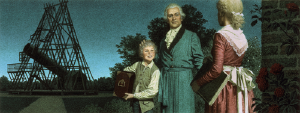Post
Father and Son
16 June 2013
 Jean Leon Huens
Jean Leon HuensWilliam Herschel was an astronomer of the 1700s and early 1800s. He is most famous for his discovery of the planet Uranus. But Herschel made several other important discoveries, including work on double stars, showing that some of them (what we now call binary stars) orbited each other under gravitational attraction. He also discovered infrared light, by passing sunlight through a prism, holding a thermometer just beyond the red light of the spectrum, and demonstrating that the thermometer was heated by in invisible light we now call infrared. He was the father of one son, John.
John Herschel became an astronomer in his own right. He worked on double stars and nebulae, and wrote a comprehensive book General Catalogue of Nebulae and Clusters of Stars which is a precursor to the New General Catalogue used by modern astronomers. John was also a photographer, chemist and inventor. One of his inventions was the actinometer, which is used to measure the heating power of sunlight. John fathered twelve children, including Alexander.
Alexander Stewart Herschel continued the line of astronomers, and focused on meteor spectroscopy. In other words, he looked at the spectra of light given off by meteors as they strike our atmosphere. Given how transitory meteors are, you can imagine this is quite a task. Alexander was able to use this work to identify comets as the source of meteor showers.
Like father, like son, as the saying goes.